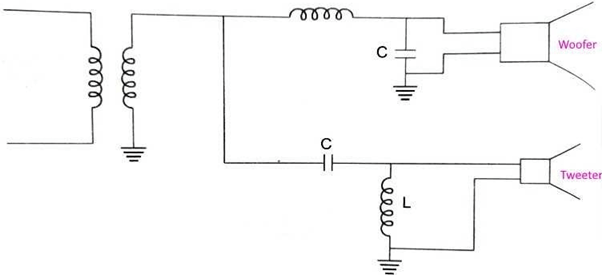This set of Audio Engineering Multiple Choice Questions & Answers (MCQs) focuses on “Audio Devices – Crossover Networks”.
1. What is termed as a network which is used to divide the input signal into separate frequency ranges for each speaker?
a) Multi-way speaker
b) Crossover network
c) Optical recording
d) Bilateral network
View Answer
Explanation: When we want to have flat frequency response over and their audible range, we have to use a multi-way speaker system to cover the entire range of audio frequencies. A network which is used to divide the input signal into separate frequency ranges for each speaker is called crossover network.
2. Crossover networks make use of the principle that the inductive reactance decreases with increase in frequency and the capacitive reactance increases with increase in frequency.
a) True
b) False
View Answer
Explanation: The above statement is false. Crossover network circuit is made of filter circuits having a cut off frequency equal to crossover frequency. Crossover networks make use of the principle that the inductive reactance increases with increase in frequency (Xl = 2πfL), and the capacitive reactance decreases with increase in frequency (Xc = 1/2πfC).
3. Which of the following network is shown in below figure?

a) Three-way system
b) Crossover
c) Blue ray
d) Optical recording
View Answer
Explanation: The crossover network is shown in the figure. A crossover network contains a woofer and a tweeter. The job of splitting the frequencies and sending them off to each speaker in the system is done by a crossover network.
4. What is termed as the point where the curve of woofer output crosses the curve of tweeter output?
a) Crossover amplitude
b) Crossover phase
c) Crossover frequency
d) Crossover cycle
View Answer
Explanation: Crossover network circuit is made of filter circuits having a cut off frequency equal to crossover frequency. The point where the curve of woofer output crosses the curve of Tweeter output is known as the crossover frequency.
5. What is the equation for capacitance in crossover network?
a) C = 1 / 2πfC√2RL
b) C = 1 / 2πfL√2RC
c) C = 100 / 2πfC√2RL
d) C = 10 / 2πfC√2RL
View Answer
Explanation: A low pass filter can be made with the series reactance of L and shunt reactance of C. Thus, the equation for capacitance in crossover network is C = 1 / 2πfC√2RL.
Where,
C = Capacitance in farads
RL = Loudspeaker impedance in ohms
fC = crossover frequency in Hz
6. What is the equation for inductance in crossover network?
a) L = √2RL / 2πfC
b) L = √2RC / 2πfL
c) L = √2RL / 20πfC
d) L = 2πfC / √2RL
View Answer
Explanation: A LPF (low pass filter) can be made with the series reactance of L and shunt reactance of C. Thus, the equation for inductance in crossover network is L = √2RL / 2πfC.
Where,
L = Inductance in Henry
RL = Loudspeaker impedance in ohms
fC = crossover frequency in Hz
7. What is the range of woofer for 3 way speaker system?
a) 20 Hz to 500 Hz
b) 50 Hz to 5000 Hz
c) 2000 Hz to 5000 Hz
d) 500 Hz to 5000 Hz
View Answer
Explanation: The crossover frequency for a woofer and tweeter circuit is where the woofer output curve crosses the tweeter output curve. The range of woofer for 3 way speaker system is 20 Hz to 500 Hz. The range of woofer for two way speaker systems is 20 Hz to 1000 Hz and range of tweeter for two way speaker system is 1000 Hz to 20,000 Hz.
8. What is the range of tweeter for 3 way speaker system?
a) 2000 Hz to 5000 Hz
b) 5000 Hz to 20,000 Hz
c) 500 Hz to 5000 Hz
d) 20 Hz to 500 Hz
View Answer
Explanation: The range of tweeter for 3 way speaker system is 5000 Hz to 20,000 Hz. The range of woofer for three way speaker systems is 20 Hz to 500 Hz and the range of squawker for three way speaker system is 500 Hz to 5000 Hz.
9. Design a crossover network to give 12 dB per octave attenuation for critical frequency of 0.5 KHz. Loudspeaker is having resistance of 8 Ω.
a) C = 200 μF, L = 5.9 mH
b) C = 28.13 μF, L = 3.6 mH
c) C = 45.78 μF, L = 2.9 mH
d) C = 67.34 μF, L = 9.9 mH
View Answer
Explanation: L = √2RL / 2πfC
C = 1 / 2πfC√2RL
Substitute the given values in the above equation.
C = 1 / 2π × 500 × 1.4 × 8
C = 28.13 μF
L = 1.4 × 8 / 2π × 500
L = 11.2 / 1000π
L = 3.6 mH
Sanfoundry Global Education & Learning Series – Audio Engineering.
To practice all areas of Audio Engineering, here is complete set of 1000+ Multiple Choice Questions and Answers.
If you find a mistake in question / option / answer, kindly take a screenshot and email to [email protected]
